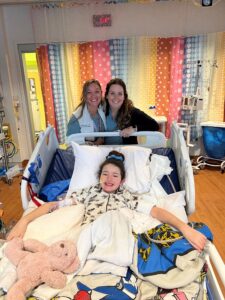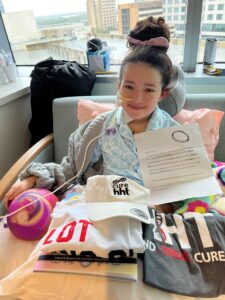More Than A Nosebleed: Collyns’ Story

After being bitten by a fire ant during recess, 10-year-old Collyns Hutson expected her school nurse to do what she always did for an allergic reaction—apply some cream, take her vitals, and send her back to her friends and class. Instead that seemingly minor event in the Fall of 2023 would escalate into a one-year diagnostic odyssey, with multiple misdiagnoses, tests, medications, and surgeries that would forever change the Hutson family’s lives. When Collyns came into the office on this day, the school nurse quickly became concerned with the low pulse oximeter reading: Collyns’ mother Amanda and father Cody took her to their local children’s hospital, but chest x-rays showed no abnormalities. Asthma, the pulmonologist concluded. Collyns was sent home with meds to combat bronchial spasms. Over the next few weeks, this pattern repeated — Collyns was short of breath and went to her school nurse, her pulse ox came back lower and lower, and the Hutson family would return to the hospital for monitoring and leave without answers. As Amanda’s frustration continued to grow, one day the school nurse called. “Mom to mom, something’s not right,” she said. “You should take her for a second opinion at a different children’s hospital.” When they took Collyns into Children’s Medical Center Dallas, her pulse ox was in the 60s and immediately the nurses and staff knew that something was wrong. They noticed Collyns’ clubbed fingers and spotted telangiectasias. A mix of hope, fear, and uncertainty arose for the family when pediatric pulmonologist Dr. Afolabi said, “I think Collyns may have HHT.” Suddenly, after weeks of the family sitting in limbo waiting for answers, things were moving quickly. An echo bubble study was ordered and additional tests would reveal micro-arteriovenous malformations (AVMs) all over her lungs. In Fall of 2023, Dr. Afolabi referred Collyns for a double lung transplant evaluation. The team wanted further work up on her liver, as they suspected hepatopulmonary syndrome. In January of 2024, the team discussed the possibility of Collyns needing a dual lung-liver transplant, but made the final decision to list her for a liver-only transplant only one month later. They felt confident that a liver transplant would heal her lungs. “Our lives had completely changed,” Amanda said emotionally, thinking back. “How did we go from having a normal ten-year old who we thought was healthy, to needing [organ] transplants? It just felt crazy.” While waiting for a match to become available, the hospital did a family history screening and genetic panel, identifying Collyns and Amanda for carrying the GDF2 gene and identified several maternal family members having the ENG gene. While Collyns presented with HHT-like symptoms and presentation, her genetic results confounded her care team. A complex case grew even more complicated. On May 16, 2024 Amanda received the call that the hospital found a liver. Two days later, Collyns received a liver transplant. Unfortunately, post-transplant, Collyns continued to worsen. The team believed Bactrim, a common antibiotic given after transplant, caused an acute lung injury. By early-July, Collyns was maxed out on support and needed to be added to the list for a new set of lungs. One week later, Collyns’ doctors came in to tell the family that they accepted an offer of lungs and were moving forward with her transplant.  Despite some post-transplant complications, Collyns’ spirit and resilience remained unbroken and she was officially discharged on August 15. “She’s okay now. She is on a ton of medications. She’s still going to physical therapy four times a week with additional occupational therapy sessions. We spend Monday through Friday at the hospital, pretty much all day,” Amanda said, laughing as she looked at her daughter. “But overall, she’s doing great.” Throughout their treatment odyssey, the Hutsons remained in close contact with Cure HHT Director of Research Programs and Grants Cassi Friday, PhD for information and resources navigating their daughter’s medical journey. When it came time for Collyns’ transplants, both Amanda and Collyns wanted to make sure that their experience could ease some of the frustration and pain future families may experience. They decided to donate a portion of both her liver and lungs to Cure HHT as a part of our new biobank research project – a program which gives researchers around the world badly needed HHT tissue, which is critical to helping advance science. Amanda remarked, “I want to help others any way we can. I have two other children who are still in the process of having genetic testing done. This process is not easy or fast. But hopefully our donation can help others in the future.” Now in recovery and diagnosis management, the Hutson family is advocating for better awareness of HHT and the different ways it can present differently in each patient. HHT is not just an occasional nosebleed and your tax-deductible donation to Cure HHT can make the difference for families like Collyns’. Your contribution will fund vital research, education, and support programs that are making a difference in the lives of people affected by HHT. Together, we can work towards a future where HHT is no longer a mystery, and where every patient receives the care they deserve.
Despite some post-transplant complications, Collyns’ spirit and resilience remained unbroken and she was officially discharged on August 15. “She’s okay now. She is on a ton of medications. She’s still going to physical therapy four times a week with additional occupational therapy sessions. We spend Monday through Friday at the hospital, pretty much all day,” Amanda said, laughing as she looked at her daughter. “But overall, she’s doing great.” Throughout their treatment odyssey, the Hutsons remained in close contact with Cure HHT Director of Research Programs and Grants Cassi Friday, PhD for information and resources navigating their daughter’s medical journey. When it came time for Collyns’ transplants, both Amanda and Collyns wanted to make sure that their experience could ease some of the frustration and pain future families may experience. They decided to donate a portion of both her liver and lungs to Cure HHT as a part of our new biobank research project – a program which gives researchers around the world badly needed HHT tissue, which is critical to helping advance science. Amanda remarked, “I want to help others any way we can. I have two other children who are still in the process of having genetic testing done. This process is not easy or fast. But hopefully our donation can help others in the future.” Now in recovery and diagnosis management, the Hutson family is advocating for better awareness of HHT and the different ways it can present differently in each patient. HHT is not just an occasional nosebleed and your tax-deductible donation to Cure HHT can make the difference for families like Collyns’. Your contribution will fund vital research, education, and support programs that are making a difference in the lives of people affected by HHT. Together, we can work towards a future where HHT is no longer a mystery, and where every patient receives the care they deserve.

My prayers are with Collyns for a speedy recovery.
Also praying for continued healthy recovery. Very cute picture Collyns.